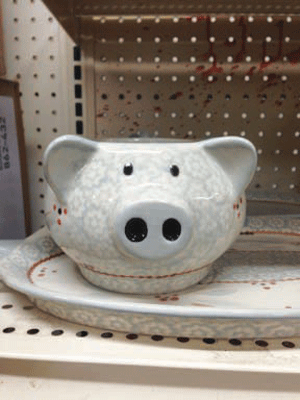
BY ELISSA STEIN | It is the best of times if you want to purchase an expensive condo in the Village loaded with amenities — or, on the other hand, a surprisingly deep selection of beef jerky.
Meanwhile, it is the worst of times if you’re valiantly searching for sponges or Saran Wrap. The reinvention of two of Sixth Ave.’s longtime markets into opposite extremes of the retail tenant spectrum leaves locals frustrated…and still longing for a supermarket.
The site formerly known as Jefferson Market has been reimagined as an exceedingly private sales office for The Greenwich Lane, the upscale condo development under construction at the former St. Vincent’s Hospital site. One can get information on residences not yet built that will range from $2 million to $16 million. But only an appointment will gain you entrance into the secretive establishment — one cannot merely walk in off the street asking for information.
From the outside, the offices are all but impenetrable, every window completely shrouded by blinds, no descriptive signs posted indicating what lies within. An outer vestibule was recently erected to shelter prospective owners as they try to get through the front door — or, to further discourage people from casually dropping by, which, unless you’re expected, isn’t possible.
So far, The Greenwich Lane is doing a remarkable job promoting itself as elitist and separate from the neighborhood it’s being built in. With amenities like a formal garden with a reflecting pool, a private lounge, a dining room with a guest chef’s kitchen along with a catering kitchen, screening room, children’s playroom, swimming pool, fitness center, golf simulator and charging stations for electric cars in the private garage, who needs the actual Village?
On the other hand, Buddy’s Small Lots, which has moved into the former Food Emporium site for at least six months, wants customers not only to come in but to save up to 80 percent, so the glaring signs plastered on the facade implore. The space had been stripped of every last shelf and display. Makeshift fluorescent lamps are strung from the ceiling marked with exposed concrete beams. Scuffed floors are lined with temporary standing racks filled with items such as automotive supplies, china serving pieces emblazoned with roosters and pigs, low-end lighting fixtures, toy knockoffs and pet treats that have long since expired.
It is apparent from the merchandise available that the stock wasn’t tailored to the neighborhood. Most in Greenwich Village don’t have garages that need flooring or the means to carry home sizable armchairs or bulky violet satin comforter sets. The store manager confirmed they’d signed a six-month lease after they had a successful pop-up store in Midtown for a couple of months. Should they do well, they were hoping to stay for a year. More than one local compared Buddy’s to what 14th St. used to be like. And while there are some staples like napkins, paper towels and certainly plenty of plastic cups, one could not shop at Buddy’s for basic groceries.
This stretch of the neighborhood was once a healthy mix of residential, retail, schools and services. But the balance has tipped. Basics, ranging from a variety-packed ice cream freezer to an emergency room and hospital, have been stripped away, leaving residents still scrambling for quality-of-life conveniences that were once an integral part of the Village.

















